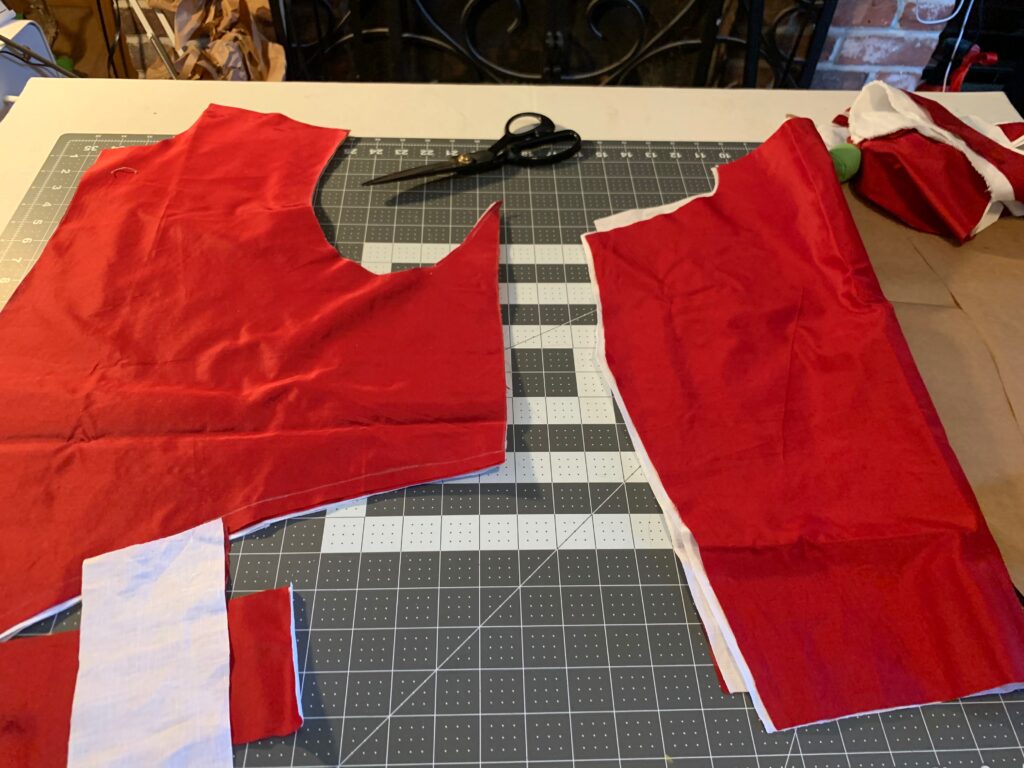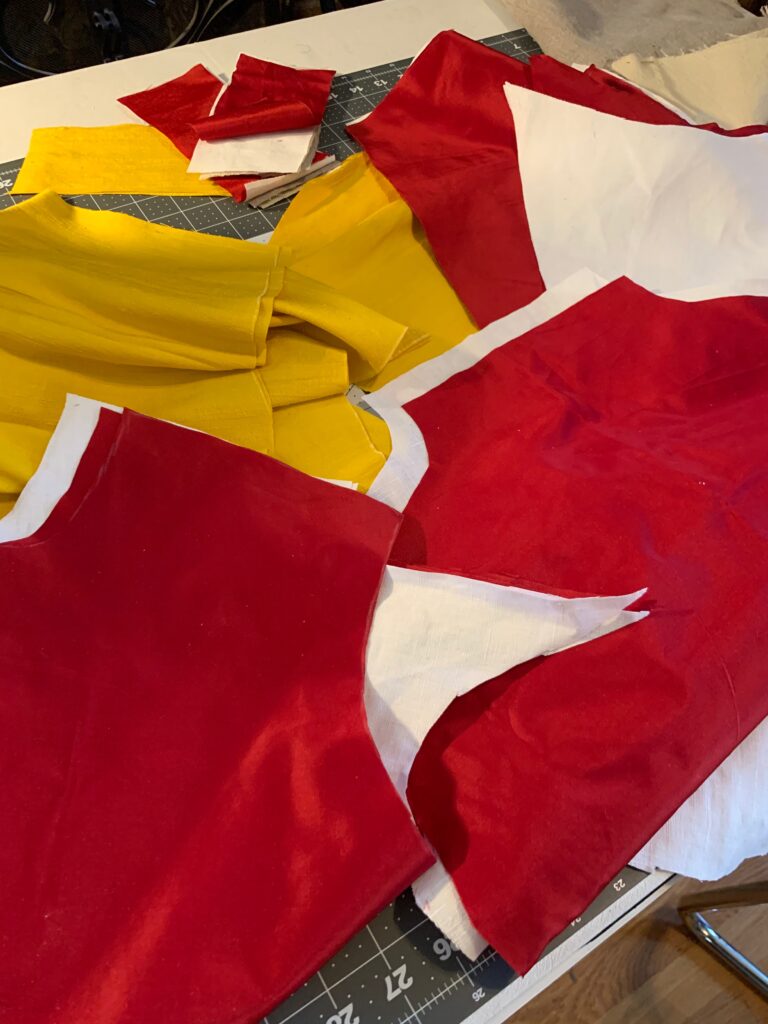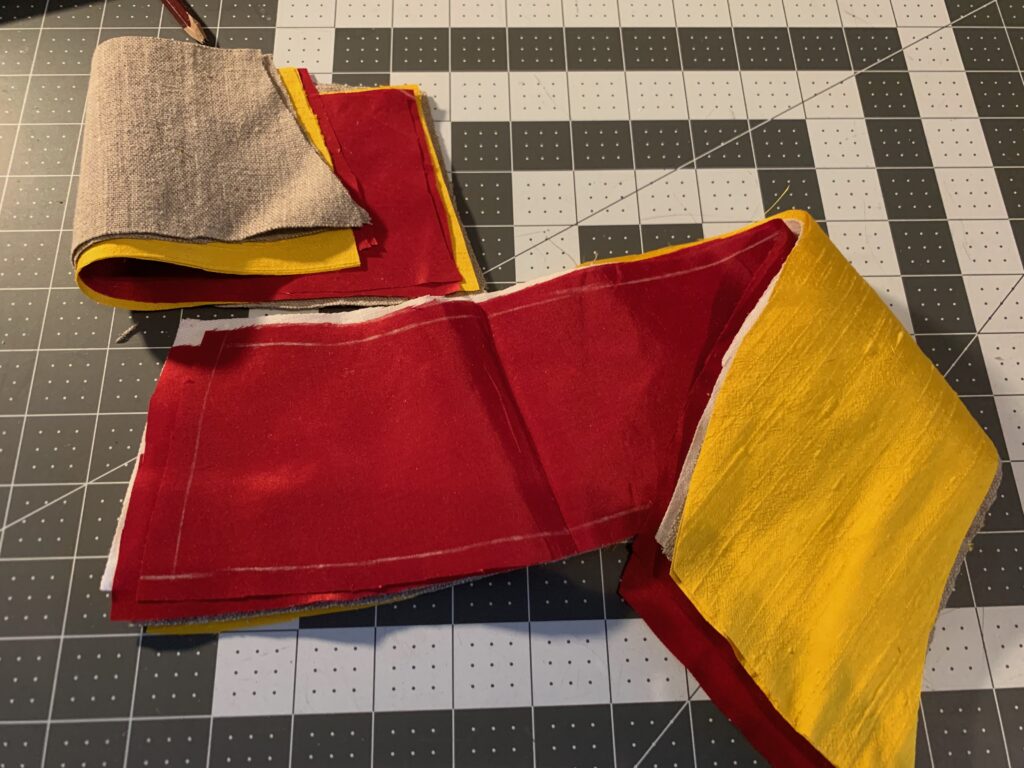Once one has drafted a pattern that works you do have to actually cut the silk. In this case, silk interlined with linen, with an interlining of coarse linen and wool, and finally a silk lining.

Interlinings 
Silk Taffeta Interlined with linen 
All the messy doublet cuts 
Doublet skirt 
Skirt layers cut
This evening I will padstitch the interlining of coarse linen and wool in the main torso and collar, and baste the silk taffeta to the medium weight linen so they respond as one fabric. Construction will follow these steps.
- The skirt is constructed fully.
- The pad-stitched doublet fronts will be attached to the outer fabric and sealed at the top and front by the lining fabric.
- The front panels of the doublet and interlinings will be joined together.
- The skirt will be sewn to the WS of the interlining layer.
- Finally, the silk lining will be sewn over the edges for a clean finish.
The pad stitching will be done with a bronze needle and coarse linen thread. I will baste with a fine steel needle and fine linen thread (unwaxed). The doublet construction will use mostly a 60/2 linen thread.
More details on on the cutting process can be found here: Fioredibardi.net
Ciao!
I am Nobildonna Fiore Leonetta Bardi (Fee-oh-re) also known as Fiore di Bardi (she/her). Primarily a costumer, I specialize in Florentine dress from the mid-1560s to ~1590, hand sewing, and embroidery. My area of interest includes research of life as an illegitimate woman in Florence, the Florentine Camerata, artifacts and practices for a noblewoman of this time — including the practice of hunting and falconry in Florence, and Florentine textiles. I am increasingly interested in the people we try not to see and which most would have tried not to see even in the 16th-century, namely those of mixed race in Europe. Especially how a person of my lineage (I am of African, French, and Spanish descent) would have lived in 16th century Italy. Motto: Penso e Creo * Blog: www.fioredibardi.net * Instagram: @dressingflorentine


You’re making great progress!
And thank you for the direct link to the relevant blog post! It made following the details of your construction/cutting much easier for this judge.
How do you do your pre-washing of your wool interlining? Do you have a particular favorite soap or detergent? Do you try to pre-fell/shrink the fabric, or treat it gently as possible (as schools of thought on this differ so widely!)? Was this done by hand or by machine?
I’m also curious where you found your period style needles, and how you like working with them compared to modern needles? (This is tangential, and can be answered after the competition is done if it takes time away from your project!)
I’m looking forward to seeing more about your pad stitching structure, and the internal construction seams before everything gets closed up, never to be seen again!
Thanks for asking about pre-washing. Wool is always on a case-by-case basis for me. This wool serge is a 2/2 twill that is pretty raw. As a result, I was pretty certain that its first encounter with water would shrink it. Since it is an interlining which would be responsible (highly manipulated of course) for maintaining the shape of the garment, it got abused. Machine washed (with vinegar and a touch of lanolin-based soap – currently have Eucalan)) and dried. I live in 750 sq ft and cannot wash in more traditional methods and live here. It was then steam ironed and pulled by hand to square. I tend to treat outer layers of wool differently and the decision to abuse or treat gently is made based on the hand of the fabric, how it seems to have been treated or conditioned, and experimentation when there is doubt. All silk is cold water washed with vinegar in my bathtub, dried by rolling in coarse linen towels, and draped to almost dried. I then iron it to get it the rest of the way.
In terms of needle, I love working linen with bone needles and everything else with bronze and tend to prefer it to modern needles. I am also experimenting with steel and iron needles and have mixed reviews. They do leave larger than average holes in the fabric but these are not evident in the finished garment in any real way. I have had to experiment quite a bit to find period-material needles that were the right size (for ease of use) and the right strength. My favorites so far are bronze needles from medieval crafts EU (etsy) and I am making my own bone needles as I like them finer than I can find to purchase. Happy to speak more about those.